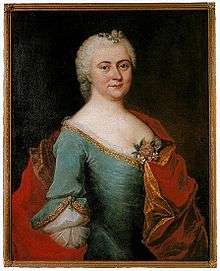Elias Gottlob Haussmann
| Elias Gottlob Haussmann | |
|---|---|
| Born |
1695 Gera, Germany |
| Died |
April 11, 1774 (aged 78–79) Germany |
| Known for | Portrait painting |
| Movement | Baroque |

Elias Gottlob Haussmann (also Haußmann or Hausmann) (1695 – 11 April 1774) was a German painter in the late Baroque era. Haussmann served as court painter at Dresden, and from 1720 as the official portraitist at Leipzig. He is mostly known for his portrait of Johann Sebastian Bach which was painted in 1746.

Oil painting by Haussmann 1726

Oil painting by Haussmann c. 1750
Life
Haussmann was born in Gera. He was at first a pupil of his father, Elias Haußmann (1663–1733), who was the Landgrave of Hesse's court painter. Haussmann was in the royal Hessian service, as he was mentioned in a September 1717 letter of recommendation from Landgrave Ernst Ludwig of Hesse-Darmstadt as "Our court painter's son".[1]
The Landgrave allowed him a study trip through Germany, where he met portraitist Francesco Carlo Rusca at Lugano.[2] Haussmann also met the Dresden court painter Ádám Mányoki, who wrote favorably of him.[1]
From 1720 Haussmann was the official portrait painter of the city of Leipzig, but left the city in 1722, probably because of differences with the Malerinnung (painters' guild) of Leipzig. Haussman and the guild quarrelled in 1729 and 1742 because he refused to become a burgher or to come to agreements with the guild.[1] These disputes are also accepted as a reason that Mányoki revoked his recommendation.[1]
In 1723, Haussmann was appointed court painter to the royal Polish and Saxon Elector, Augustus II the Strong. In 1725 he returned to Leipzig. In 1726 he took over the clientele of his predecessor, beginning with a portrait of the merchant Johann Heinrich Linke. In the 1760s, he and his school were replaced by Ernst Gottlob and Anton Graff.[1] Haussmann was also a long-time painter of the Protestant clergy.[1]
Works
The City Historical Museum of Leipzig, where the Bach portrait hangs, also has several other oil paintings by Haussmann and a variety of his copperplate engravings. Most Haussmann paintings can easily be attributed – he regularly signed his works on the back with his name and the date.[1]
Haussmann's early portraits, like that of Gottfried Reiches, display individual composition, technical careful execution, a high level of detail, and realistic emotional expressions. Many later portraits on the other hand, possess typical characteristics of serial images. Especially in the years after 1760, they use the same measurements and often show the subjects in the same attitude. Often there are identical clothes in the same colors within a series of portraits of rather insignificant officials. Georg Müller writes of an "image factory".[1]
Engravings made by others were enhanced with titles, career and personal data.[3]
Haussmann's oil paintings and the larger number of etchings [1] show a cross section of the leading layer of the bourgeoisie of Leipzig from the fields of politics, administration, judiciary, the church, business (especially trade and crafts), science and art. Examples include:[3]
- Mayor Gottfried Wilhelm Küster
- Councillor and builder Kaspar Richter
- Councillor and city judge Johann Jacob Mascov
- Pastor Gottlieb Gauditz
- Archdeacon Christian Weiß
- Councillor and merchant Johann Zacharias Richter
- Merchant Johann Heinrich Linke
- Jurist Christian Gottfried Moerlin
- University professor August Friedrich Müller
- Composer Johann Sebastian Bach
- Senior municipal musician Gottfried Reiche
- Writer Luise Gottsched
References
- 1 2 3 4 5 6 7 8 9 Georg Müller (1907–1947). "Elias Gottlob Haussmann". In Ulrich Thieme, Felix Becker; et al. Allgemeines Lexikon der Bildenden Künstler von der Antike bis zur Gegenwart. 16. Leipzig. pp. 145–146.
- ↑ Art of Bach, paintings and drawings from collections East Germany. Leipzig. 1985.
- 1 2 Werner Neumann, ed. (1979). Bilddokumente zur Lebensgeschichte Johann Sebastian Bachs – Supplement to Johann Sebastian Bach, Neue Ausgabe sämtlicher Werke. IV. Kassel.
Sources
- Gurlitt, Cornelius. Descriptive representation of the earlier works of art and monuments of the Kingdom of Saxony. These include the official main team Leipzig City, 1894–1895
- Sigismund, Ernst (1929). "The painter of portraits E. Bach G. Haussmann, a Gedenkblatt". Illustrated Magazine for Culture, Science and Transportation. Leipzig.
- "The portrait painter Elias Gottlob Haussmann and his time: the Bach–portraits". Magazine for Art. 4 (2): 126–135. 1950.
- Wustmann, Gustav (1907). Der Leipziger Kupferstich im 16., 17. und 18. Jahrhundert [Leipzig's engraving in the 16th, 17th and 18th centuries]. J.B. Hirschfeld. OCLC 37772735.
External links
 Media related to Elias Gottlob Haußmann at Wikimedia Commons
Media related to Elias Gottlob Haußmann at Wikimedia Commons- Altes Rathaus, museum in Leipzig housing many of Haussmann's paintings, including the famous Bach portrait